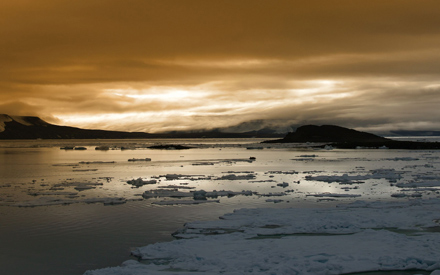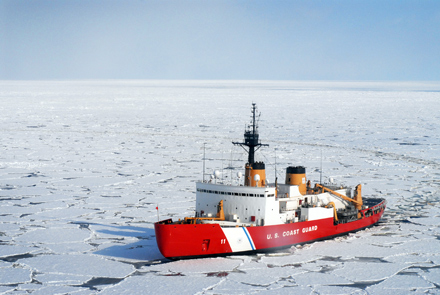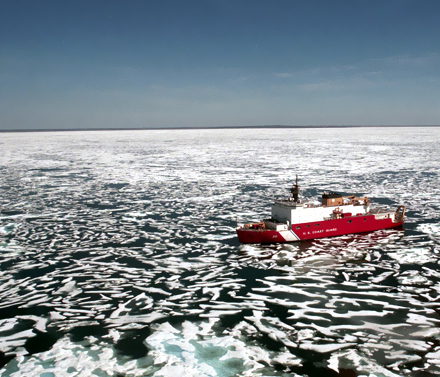Oil Spill Response in Arctic Requires Further Study
The Macondo oil spill has prompted government regulatory agencies worldwide to study the environmental impact of an oil spill and how to respond to such an incident. This concern appears to be even greater for the Arctic, which has been relatively undeveloped and is viewed as a pristine environment with a delicate ecosystem.

The issue of oil spill clean-up in ice continues to grow in importance as exploration drilling outside of the traditional summer open water period becomes more and more technically feasible with advanced marine technology, supported by active ice management and capable vessels, according to David Dickins of DF Dickins Associates LLC at the Arctic Technology Conference in Houston last month.
"Future advances in our ability to respond to spills in ice will require a new approach to permitting experimental spills. The record shows that it is entirely possible to plan and execute experiments safely with no harm to the environment," Dickins said. "Continued regulatory intransigence could jeopardize industry's ability to develop credible and effective contingency plans to permit future Arctic exploration and development activities."
While the possibility of a late-season blowout is remote, operators need to have a credible oil discharge contingency plan to cover the possibility of large volumes of oil becoming trapped under moving ice and potentially drifting unrecovered through the winter.
Sea ice is found in numerous forms across the Arctic for between six and nine months each year. The behavior of oil in ice depends greatly on the oil properties and discharge conditions. Data has been gathered from field experiments, laboratory tests, analytical studies and oil spills over the past 40 years that has led to a good understanding of the basic processes of controlling oil's behavior, including in static fast ice and drifting ice. Most of this work has been performed in the U.S., Canada and Norway.
Key observations from large-scale field experiments are that the natural containment, reduced wave action and slower weathering in the presence of significant ice cover, can greatly extend the windows of opportunity and effectiveness for response operations such as burning and dispersant application. These benefits are not experienced with traditional response options relying on boom and skimmer systems where ice interference severely reduces the recovery effectiveness.
The behavior of oil spilled under multi-year ice or "old" still requires further study. As exploration moves into deepwater in the Beaufort Sea and offshore Greenland, spill scenarios involving this much thicker, less porous ice will become increasingly important, Dickins said.
U.S. Coast Guard Study
The U.S. Coast Guard has been studying how to respond to an Arctic oil spill using data gathered from studying the Great Lakes, which, like the Arctic, is experiencing the effects of climate change. This includes the potential for a longer shipping season and lower water levels, both of which could increase the risk of an oil spill.

The Coast Guard's Research and Development Center started a project in 2009 to determine if exercises could be used to evaluate technologies in parallel with other developmental efforts to prepare a comprehensive approach to response, such as in-situ burning. This spring, the Coast Guard is expected to deploy a limited exercise in the area of Sault St. Marie, Michigan for an oil exercise.

Pipeline Leaks
The Arctic's remoteness and sensitive environs make primary and supplemental leak detection systems for offshore pipeline projects critical in order to detect all potential leak sizes from an offshore Arctic pipeline project, according to Ben Eisler, supervising engineering specialist with INTECSEA. A chronic pipeline leak can develop into a large volume oil spill while shielded from view by winter Arctic conditions, which last from ice cover freeze-up around mid-November through ice break-up periods in mid-April.
While internal computer-based leak detection systems may be considered offshore West Africa or in the deepwater Gulf, these systems are limited in detecting the smallest potential leak sizes while limiting false alarms, meaning a leak below the minimum leak detection threshold may be undetected. Alternative leak detection systems such as LEOS vapor analyzing systems, pipe-in-pipe vacuum annulus monitoring, or fiber optic technologies, may help to serve as primary or supplementary leak detection systems to reduce the leak detection threshold for subsea arctic pipelines so that small chronic leaks may be detected.
However, these alternative technologies have distance limitations; the LEOS systems may require a manned offshore facility or shore crossing to run periodic sensing. Some projects may have technical challenges associated with installation of pipelines and components for supplementary external leak detection systems, such as a pipeline bundle that may be physically installable from winter ice.
Operational experience with the Northstar and Oooguruk pipelines show that offshore arctic pipelines can provide safe and reliable transportation systems for oil and gas development projects. However, there is limited pipeline industry experience with offshore arctic and sub-arctic conditions. "It is therefore important to design, construct and operate these pipelines as complete systems which are capable of continued safe operations even in response to loading conditions which may not have been fully defined during the early stages of the project."
WHAT DO YOU THINK?
Generated by readers, the comments included herein do not reflect the views and opinions of Rigzone. All comments are subject to editorial review. Off-topic, inappropriate or insulting comments will be removed.
- How Likely Is an All-Out War in the Middle East Involving the USA?
- Rooftop Solar Now 4th Largest Source of Electricity in Australia
- US Confirms Reimposition of Oil Sanctions against Venezuela
- EU, Industry Players Ink Charter to Meet Solar Energy Targets
- Analyst Says USA Influence on Middle East Seems to be Fading
- Russian Ships to Remain Banned from US Ports
- Brazil Court Reinstates Petrobras Chair to Divided Board
- EIB Lends $425.7 Million for Thuringia's Grid Upgrades
- Var Energi Confirms Oil Discovery in Ringhorne
- Seatrium, Shell Strengthen Floating Production Systems Collaboration
- An Already Bad Situation in the Red Sea Just Got Worse
- What's Next for Oil? Analysts Weigh In After Iran's Attack
- USA Regional Banks Dramatically Step Up Loans to Oil and Gas
- EIA Raises WTI Oil Price Forecasts
- How Likely Is an All-Out War in the Middle East Involving the USA?
- Venezuela Authorities Arrest Two Senior Energy Officials
- Namibia Expects FID on Potential Major Oil Discovery by Yearend
- Oil Markets Were Already Positioned for Iran Attack
- Is The Iran Nuclear Deal Revival Project Dead?
- Petrobras Chairman Suspended
- Oil and Gas Executives Predict WTI Oil Price
- An Already Bad Situation in the Red Sea Just Got Worse
- New China Climate Chief Says Fossil Fuels Must Keep a Role
- Oil and Gas Execs Reveal Where They See Henry Hub Price Heading
- Equinor Makes Discovery in North Sea
- Macquarie Strategists Warn of Large Oil Price Correction
- DOI Announces Proposal for Second GOM Offshore Wind Auction
- Standard Chartered Reiterates $94 Brent Call
- Chevron, Hess Confident Embattled Merger Will Close Mid-2024
- Analysts Flag 'Remarkable Feature' of 2024 Oil Price Rally


